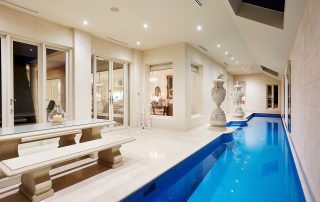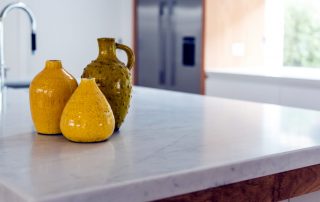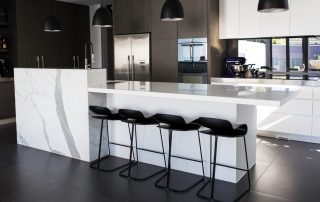Which Stone is Best?
It’s all about “Location, location, location!”
Where the stone will be located determines which stone is best and what treatment it will require.
Is it a wet area or dry area?
How much foot traffic will it be exposed to?
What elements will the stone be exposed to?
Will the stone be exposed to acidic substances, such as wine, juice, coffee, etc.?
Will it be exposed to soap scum?
Does the stone need to be slip resistant?
What is the overall design and décor of the surroundings?
Kitchens are subject to frequent exposure to acidic liquids so a stone that is hard wearing and resistant to absorption is required.
Although very beautiful in the kitchen, marble can etch with acidic substances. Therefore if used in the kitchen it will require a high quality protective coating to help prevent this.
Granite is highly scratch and heat resistant, virtually non-absorbent once sealed, and is resistant to most chemicals, making it an ideal choice for the kitchen.
Bathrooms are subject to the build up of soap scum, oils, dirt and mineral deposits from water so it’s important to select a stone that is fairly resistant to absorption and one that can be easily cleaned.
Polished and sealed marble, limestone or granite are ideal choices.
These types of areas are subject to extreme levels of foot traffic and will therefore require regular maintenance to keep it looking its best.
Polished marble, granite or terrazzo work very well in these areas with regular professional maintenance.
Outdoor areas will obviously be exposed to varying degrees of weathering: sun, rain, pollution, pool chemicals, etc.
Stone that is slip resistant and has a matt finish such as sandstone, slate or blue stone is ideal for outdoor areas.
The type of structural application and architectural design will determine the best stone to use.
It is important to consider polishing, sealing and maintenance and make sure the structure can be readily accessed for future cleaning and maintenance.
Important considerations when using stone for structural applications:
- Will it be supporting a structure?
- Is the stone capable of supporting such a structure?
- Is it accessible for future maintenance?
- Does the stone suit the size and area of the structure?
There are so many choices of stone colour and appearance. Before deciding, ask the following:
Does your choice of stone come in the colour you’re after?
Is the area large or small?
Is the ceiling high or low?
How much natural light is available?
Will the colour chosen make the area appear smaller/larger?
What other sources of light are available and how will this impact the colour chosen?
What other colours are in the surrounding décor?
Will the colour show dirt, dust, breadcrumbs, etc.?
What type of pattern do you prefer? (Marble has a vein-like appearance and granite has a flecked effect.)
Do you need to consider variations in pattern between tiles and slabs of stone? (Being natural stone, variations are common.)
The type and purpose of the stone will determine the best finish.
Marble can be polished to a high gloss finish but sandstone can’t be.
Low sheen finishes are more practical in areas exposed to high foot traffic.
Questions to ask:
Does the stone have a functional or aesthetic purpose?
Will the stone be exposed to water and require slip resistance?
How much foot traffic will the stone be subjected to?
What about exposure to dirt or sand?
Can the stone be polished?
Is the stone exposed to soap scum?
Is the stone in a kitchen and exposed to acidic liquids?
Maintenance is very important to consider. If aesthetics win out over practical application then the maintenance costs can be substantial and need to be budgeted for.
Using a high gloss finish on flooring in a high foot traffic area is fine but be mindful that the cost of regular maintenance and polishing will be more than if a low sheen finish is chosen.
It is important to choose the correct type of stone with the right finish for the required application. Choosing the wrong type of stone for the environment it is to be used may prove costly.
Consider:
How frequently will the stone need to be cleaned/sealed/polished?
Are special products required to maintain the stone?
Is the colour fairly consistent or does it vary greatly from one end to the other?
Is there enough in the same stone with the same colour to complete the job?
Will the stone have a manufacturer’s factory seal applied?
Is the stone thick enough? (a thin slab may not be strong enough)
Are there any holes or fissures that have been resined for extra strength? (Look for dark drip marks on the rough edge of the slab which means it has been resined)
Do the tiles have a smooth or a sharp edge? (sharp are cheaper)
Some minerals in stone will polish differently – look to see if the finish is consistent, check the reflection.
Melbourne’s Most Trusted Stone Restoration & Repair Service
GIVE US A CALL ON 03 9532 1758 NOW






